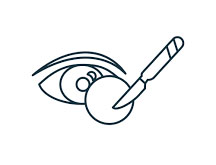
Pediatric cataract surgery is a delicate procedure performed on children who have developed cataracts in their eyes. Cataracts in children can be congenital (present at birth) or acquired due to various factors such as trauma or certain medical conditions.
The surgical procedure involves the removal of the cloudy lens from the eye and, in many cases, the insertion of an artificial intraocular lens (IOL) to restore clear vision. Here are some key points about pediatric cataract surgery:
Preoperative Evaluation:
- A thorough examination of the child's eyes is conducted to assess the extent of the cataract and any associated conditions.
- Special considerations are given to the child's age and the potential impact on visual development.
Anesthesia:
- Pediatric cataract surgery is usually performed under general anesthesia to ensure the child remains still and comfortable during the procedure.
Surgical Techniques:
- Several surgical techniques can be employed, including phacoemulsification, which uses ultrasound energy to break up and remove the cataract.
- In some cases, an anterior or posterior capsulotomy may be performed to open the lens capsule or remove any remaining lens material.
Intraocular Lens Implantation:
- The choice of intraocular lens depends on the child's age and other factors.
- In some cases, especially in infants, the use of contact lenses or glasses may be considered after surgery.
Postoperative Care:
- Close postoperative monitoring is essential to ensure proper healing and visual development.
- Eye drops and medications may be prescribed to prevent infection and control inflammation.
Visual Rehabilitation:
- Vision therapy and follow-up care are often necessary to support the child's visual development.
- Regular eye examinations are crucial to address any refractive errors or complications.
Challenges:
- Pediatric cataract surgery may present unique challenges, including the potential for amblyopia (lazy eye) and the need for ongoing management.
It's important for parents and caregivers to work closely with the pediatric ophthalmologist to ensure optimal outcomes and provide the necessary support for the child's visual development. If you're interested in this topic, do you have specific questions or are you considering this from a medical perspective?